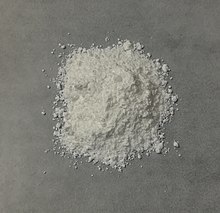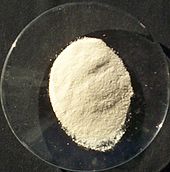Cerium compounds
Cerium compounds are compounds containing the element cerium (Ce), a lanthanide. Cerium exists in two main oxidation states, Ce(III) and Ce(IV). This pair of adjacent oxidation states dominates several aspects of the chemistry of this element. Cerium(IV) aqueous solutions may be prepared by reacting cerium(III) solutions with the strong oxidizing agents peroxodisulfate or bismuthate. The value of E⦵(Ce4+/Ce3+) varies widely depending on conditions due to the relative ease of complexation and hydrolysis with various anions, although +1.72 V is representative. Cerium is the only lanthanide which has important aqueous and coordination chemistry in the +4 oxidation state.[1]
Halides
[edit]
Cerium forms all four trihalides CeX3 (X = F, Cl, Br, I) usually by reaction of the oxides with the hydrogen halides. The anhydrous halides are pale-colored, paramagnetic, hygroscopic solids. Upon hydration, the trihalides convert to complexes containing aquo complexes [Ce(H2O)8-9]3+. Unlike most lanthanides, Ce forms a tetrafluoride, a white solid. It also forms a bronze-colored diiodide, which has metallic properties.[2]
Aside from the binary halide phases, a number of anionic halide complexes are known. Fluoride gives the Ce(IV) derivatives CeF4−8 and CeF2−6. Chloride gives the orange CeCl2−6.[1]
Oxides, sulfides, etc.
[edit]Cerium(IV) oxide ("ceria") has the fluorite structure, similarly to the dioxides of praseodymium and terbium. Ceria is a nonstoichiometric compound, meaning that the real formula is CeO2-x, where x is about 0.2. Thus, the material is not perfectly described as Ce(IV). Ceria reduces to cerium(III) oxide with hydrogen gas.[3]
Many nonstoichiometric chalcogenides are also known, along with the trivalent Ce2Z3 (Z = S, Se, Te). The monochalcogenides CeZ conduct electricity and would better be formulated as Ce3+Z2−e−. While CeZ2 compounds are known, they are polychalcogenides with cerium(III): cerium(IV) derivatives of S, Se, and Te are unknown.[3]
Cerium(IV) complexes
[edit]
The compound ceric ammonium nitrate ("CAN") (NH4)2[Ce(NO3)6] is the most common cerium compound encountered in the laboratory. The six nitrate ligands bind as bidentate ligands. The complex [Ce(NO3)6]2− is 12-coordinate, a high coordination number which emphasizes the large size of the Ce4+ ion. CAN is popular oxidant in organic synthesis, both as a stoichiometric reagent[4] and as a catalyst.[5] It is inexpensive, easily handled. It operates by one-electron redox. Cerium nitrates also form 4:3 and 1:1 complexes with 18-crown-6 (the ratio referring to that between cerium and the crown ether).
Classically CAN is a primary standard for quantitative analysis.[6][7] Cerium(IV) salts, especially cerium(IV) sulfate, are often used as standard reagents for volumetric analysis in cerimetric titrations.[8]

Cerium(III) and terbium(III) have ultraviolet absorption bands of relatively high intensity compared with the other lanthanides, as their configurations (one electron more than an empty or half-filled f-subshell respectively) make it easier for the extra f electron to undergo f→d transitions instead of the forbidden f→f transitions of the other lanthanides.[9] Cerium(III) sulfate is one of the few salts whose solubility in water decreases with rising temperature.[10]

Due to ligand-to-metal charge transfer, aqueous cerium(IV) ions are orange-yellow.[11] Aqueous cerium(IV) is metastable in water[12] and is a strong oxidizing agent that oxidizes hydrochloric acid to give chlorine gas.[1]
In the Belousov–Zhabotinsky reaction, cerium oscillates between the +4 and +3 oxidation states to catalyze the reaction.[13]
Organocerium compounds
[edit]Organocerium chemistry is similar to that of the other lanthanides, often involving complexes of cyclopentadienyl and cyclooctatetraenyl ligands. Cerocene (Ce(C8H8)2) adopts the uranocene molecular structure.[14] The 4f electron in cerocene, Ce(C
8H
8)
2, is poised ambiguously between being localized and delocalized and this compound is also considered intermediate-valent.[15]
Alkyl, alkynyl, and alkenyl organocerium derivatives are prepared from the transmetallation of the respective organolithium or Grignard reagents, and are more nucleophilic but less basic than their precursors..[16][17]
See also
[edit]- Praseodymium compounds, Terbium compounds (other lanthanide compounds that can form in the +4 oxidation state)
- Thorium compounds (actinide analogue)
References
[edit]- ^ a b c Greenwood and Earnshaw, pp. 1244–8
- ^ Greenwood and Earnshaw, pp. 1240–2
- ^ a b Greenwood and Earnshaw, pp. 1238–9
- ^ Nair, Vijay; Deepthi, Ani (2007). "Cerium(IV) Ammonium NitrateA Versatile Single-Electron Oxidant". Chemical Reviews. 107 (5): 1862–1891. doi:10.1021/cr068408n. PMID 17432919.
- ^ Sridharan, Vellaisamy; Menéndez, J. Carlos (2010). "Cerium(IV) Ammonium Nitrate as a Catalyst in Organic Synthesis". Chemical Reviews. 110 (6): 3805–3849. doi:10.1021/cr100004p. PMID 20359233.
- ^ Lide, D. R., ed. (2005). CRC Handbook of Chemistry and Physics (86th ed.). Boca Raton (FL): CRC Press. ISBN 0-8493-0486-5.
- ^ Gupta, C. K. & Krishnamurthy, Nagaiyar (2004). Extractive metallurgy of rare earths. CRC Press. p. 30. ISBN 978-0-415-33340-5.
- ^ Gschneidner K.A., ed. (2006). "Chapter 229: Applications of tetravalent cerium compounds". Handbook on the Physics and Chemistry of Rare Earths, Volume 36. The Netherlands: Elsevier. pp. 286–288. ISBN 978-0-444-52142-2.
- ^ Greenwood and Earnshaw, pp. 1242–4
- ^ Daniel L. Reger; Scott R. Goode; David Warren Ball (2 January 2009). Chemistry: Principles and Practice. Cengage Learning. p. 482. ISBN 978-0-534-42012-3. Retrieved 23 March 2013.
- ^ Sroor, Farid M.A.; Edelmann, Frank T. (2012). "Lanthanides: Tetravalent Inorganic". Encyclopedia of Inorganic and Bioinorganic Chemistry. doi:10.1002/9781119951438.eibc2033. ISBN 978-1-119-95143-8.
- ^ McGill, Ian. "Rare Earth Elements". Ullmann's Encyclopedia of Industrial Chemistry. Vol. 31. Weinheim: Wiley-VCH. p. 190. doi:10.1002/14356007.a22_607. ISBN 978-3527306732.
- ^ B. P. Belousov (1959). "Периодически действующая реакция и ее механизм" [Periodically acting reaction and its mechanism]. Сборник рефератов по радиационной медицине (in Russian). 147: 145.
- ^ Greenwood and Earnshaw, pp. 1248–9
- ^ Schelter, Eric J. (20 March 2013). "Cerium under the lens". Nature Chemistry. 5 (4): 348. Bibcode:2013NatCh...5..348S. doi:10.1038/nchem.1602. PMID 23511425.
- ^ Mikhail N. Bochkarev (2004). "Molecular compounds of "new" divalent lanthanides". Coordination Chemistry Reviews. 248 (9–10): 835–851. doi:10.1016/j.ccr.2004.04.004.
- ^ M. Cristina Cassani; Yurii K. Gun'ko; Peter B. Hitchcock; Alexander G. Hulkes; Alexei V. Khvostov; Michael F. Lappert; Andrey V. Protchenko (2002). "Aspects of non-classical organolanthanide chemistry". Journal of Organometallic Chemistry. 647 (1–2): 71–83. doi:10.1016/s0022-328x(01)01484-x.
